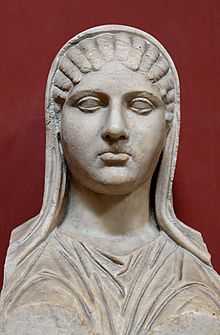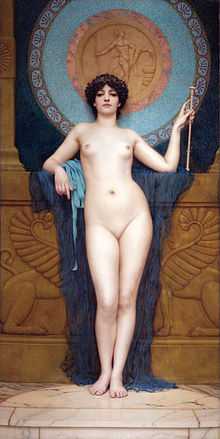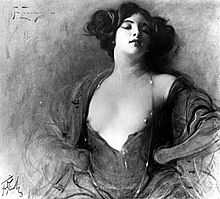Hetaira

In ancient Greece, hetairai (/hɪˈtaɪraɪ/; sing. hetaira /hɪˈtaɪrə/; also hetaera /hɪˈtɪrə/, pl. hetaerae /hɪˈtɪriː/; Ancient Greek: ἑταίρα, "companion," pl. ἑταῖραι) were courtesans—educated, sophisticated female companions. Although most of them engaged in sexual relations with their patrons, hetairai were not simple prostitutes.
Overview
In ancient Greek society, hetairai were independent and sometimes influential women who wore distinctive dresses and had to pay taxes. Mostly ex-slaves from other cities, these courtesans were renowned for their achievements in dance and music, as well as for their physical and intellectual talents. Unlike most other women in Greek society at the time, hetairai were educated. Τhey were also the only women who actively took part in the symposia, where their opinion was welcomed and respected by men. Hetairai also were the only class of women in ancient Greece with access to and independent control over considerable amounts of money.[1] Hetairai should not be confused with pornai of the time, who sold sex by the act and worked on the streets or out of brothels.[2]
Ancient Greek hetaira have been compared to the earlier Babylonian nadītu, the Japanese oiran, and the Korean kisaeng.

In Plutarch's Life of Demetrius the king is depicted making light of marriage by simultaneously having many wives as well as consorting with freeborn women and hetairai, with Lamia of Athens his favourite. Plutarch mentions her in as many as fourteen anecdotes. She was once a member of Ptolemy I Soter's entourage and played the flute. Many women musicians in ancient Greece were also prostitutes, but this is not known of Lamia before her involvement with Demetrius. The hetairai involved with kings were noticeably monogamous. Polemon tells us that Lamia was the daughter of the Athenian citizen, Cleanor, and that she built the stoa or art gallery at Sicyon as a benefaction to the people. She was renowned not only for beauty and charm, but also great wit.[3]
Other famous hetairai were the Ioninan Thargelia;[4] Aspasia, the companion of Pericles; Archeanassa, companion of Plato; the famous Neaira; Thaïs, a concubine of Alexander's general Ptolemy, later king of Egypt; Lais of Corinth, a famed beauty during the Peloponnesian War; Lais of Hyccara, a courtesan said to have consorted free of charge with the philosopher Diogenes; and Phryne, the splendid model and muse of the sculptor Praxiteles.
The status of hetairai was contrasted to that of prostitutes (πόρναι pornai), mistresses (παλλακίδες pallakides), and wives (γυναῖκες gynaikes). In the oration Against Neaera,[5] Demosthenes said:
- “We have hetaerae for pleasure, pallakae to care for our daily body’s needs and gynaekes to bear us legitimate children and to be faithful guardians of our households.”

Demosthenes mentions that Neaira's purchase price (both for her original purchase by Timanoridas of Corinth and Eucrates of Leucas and her own subsequent purchase of her freedom) was 30 minas. Since the mina was equal to 100 drachmae and the drachma can be thought of as equivalent to the daily wage of a skilled worker, this would make her purchase price the equivalent of 8 years of a worker's salary.
The hetaira business had implications in fashion and taste beyond the realm of prostitution. As sex and sexuality in Greek culture evolved, courtesans were inclined to follow suit to stay fashionable and to keep up with business. The reverse is also true—as certain aspects of hetaira culture became popular, they would diffuse into everyday Greek life and fashion as well. For example, Athenian women seemed to have imitated the styles of prostitutes. This included the removal of pubic hair, applying makeup, and adopting their style of dress.[6]
The male form of the word, hetairos (ἑταῖρος; pl. ἑταῖροι hetairoi), signified a male business or political associate. Most famously, it referred to Alexander the Great's bodyguard cavalry unit (see Companion cavalry).
In Jungian psychology, the hetaere is one of Toni Wolff's four feminine archetypes.
Simone de Beauvoir devotes significant discussion to the hetaira type in The Second Sex.
See also
- Prostitution in Ancient Greece
- Primitive promiscuity
- Religious prostitution
- All pages beginning with "Hetair-"
References
- ↑ Pomeroy, Sarah (1975). Goddesses, Whores, Wives, and Slaves. New York: Schocken Books. p. 91.
- ↑ Hamel, Debra (2003). Trying Neaira. Harrisonburg, Virginia: R.R. Donnelly & Sons. p. 5.
- ↑ Whiteley, Rebekah (2000). "Courtesans and Kings: Ancient Greek Perspectives on the Hetairai" (PDF).
- ↑ Plutarch, Pericles, XXIV
- ↑ Demosthenes, Oration 59.122
- ↑ Garrison, Daniel H. (2000). Sexual Culture in Ancient Greece. Norman, Oklahoma: University of Oklahoma Press. p. 144.
- Davidson, J. (1998). Courtesans and Fishcakes: The consuming passions of classical Athens. London: Fontana.
External links
| Wikimedia Commons has media related to Hetaeras. |